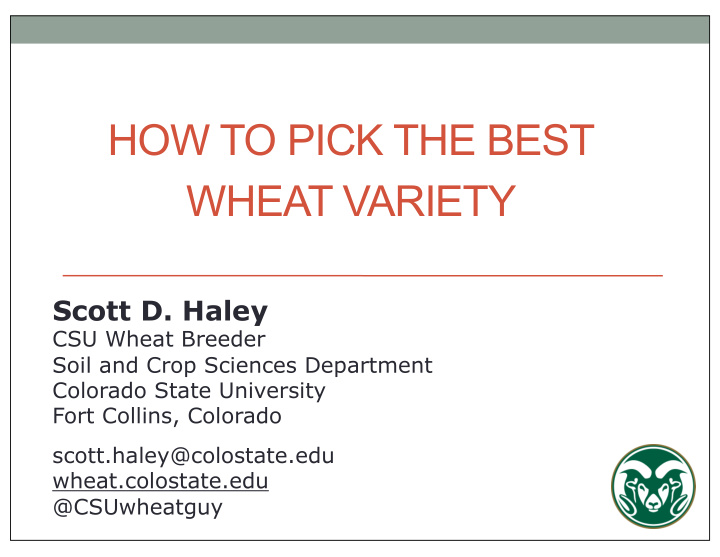



HOW TO PICK THE BEST WHEAT VARIETY Scott D. Haley CSU Wheat Breeder Soil and Crop Sciences Department Colorado State University Fort Collins, Colorado scott.haley@colostate.edu wheat.colostate.edu @CSUwheatguy
Famous Statisticians and Quotes There are three kinds While it is easy to lie with of lies: lies, damned statistics, it is even easier lies, and statistics. to lie without them. - Mark Twain - Frederick Mosteller
Wheat Variety Trial Data • What are the sources of variation in these trials? - Test entries (varieties, “genotypes”): most common focus - Locations: also a common focus, much more complicated - Years: equally important & complicated, less controllable - Interactions among the above (I’ll come back to this … ) • Dataset - All CSU dryland variety trial data from 1990-2015 - 26 years of testing - 25 trial “locations”, 2-3 replications per location - 220 unique year x location combinations - 219 different test entries (released varieties and lines) - 22,392 total observations for yield and test weight
So What Does This Tell Us? • Partitioning of Trial Variance - Variation attributed to test entries (varieties) is a relatively small part of the total variation (7%). - The largest portion (75%) is due to non-genetic effects. - Interactions between the variety and the environment are larger than the variety effect itself (18%). - The interactions compromise variety testing (and breeding). • Questions - Given the magnitude of these interactions, how many years should we test to get an accurate assessment? - Given their magnitude, how many trial locations provide the most accurate assessment?
Interactions Involving Varieties • Interactions between the variety and the test environment reduce progress through breeding and compromise variety selection decisions. • Genotype x environment interaction (GxE) – the difference in the relative performance (i.e. yield) of varieties across different environments. • Questions - What does GxE look like in a general sense? - What does GxE look like with regard to the variety’s response to Colorado’s highly variable environments? - How can our knowledge of GxE be used to help make more accurate variety selection decisions?
Genotype x Environment Interaction • In reality, response patterns among test entries across years and locations are much more complex. • In any given year or set of data all different types and patterns of GxE interaction are present. • AMMI analysis – additive main effects and multiplicative interaction (or French: ami = friend) - Widely used statistical procedure for assessing GxE interaction in plant breeding. - Allows visualization of the effects of both the environment and the genotype (variety) on the same plot. - Allows visualization of the interaction.
This is All Very Interesting, But So What? • Field trialing for wheat breeding – and wheat variety testing – is imperfect. But it’s the best we have. • Some traits are more predictable than others, like test weight. Some are more complex, like grain yield. • Predictability improves with increased testing (years and trial locations). So use all the data available. • Geography is not a very good predictor of the presence of interaction. Restricting geography restricts the accuracy of comparisons & prediction. • Variety performance is very complicated.
http://ramwheatdb.com
Percentage Superior Comparison Year-Location Comparison (better= bold ) “Trial Wins” Comparison (top LSD group) Overall Comparison
Acknowledgements
Recommend
More recommend